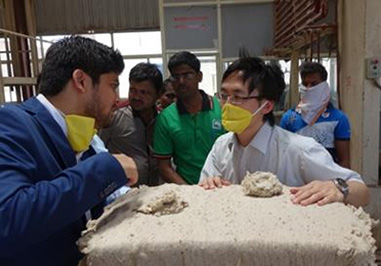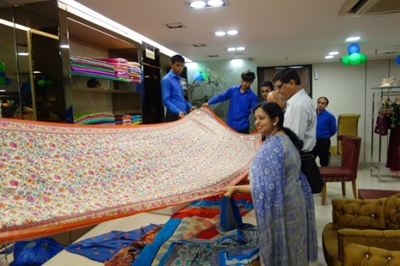Press Releases
Participation in Business Call to Action led by United Nations Development Programme
Cupro business of Asahi Kasei contributes to development of India’s fiber industry
May 24, 2016
Asahi Kasei Corp.
Asahi Kasei has joined the Business Call to Action (BCtA)1 led by the United Nations Development Programme (UNDP)2 with an initiative to raise the skills of local producers and young people in India for the production process of cupro regenerated cellulose fiber from the procurement of raw materials to the manufacture of finished fabric. This initiative also aims to create new employment opportunities in the fiber industry in India, and foster young talent that will advance the development of India’s fashion industry.

Cupro is a regenerated cellulose fiber made from cotton linter, the short fibers on cotton seeds. Featuring a smooth feel and environmental compatibility as a naturally derived material, it is widely used for the lining of high-quality suits, as well as many other applications such as outerwear, innerwear, bedding, and sportswear. In order to meet growing demand in Indian traditional garments (saris, scarfs, etc.), Asahi Kasei constructed a new production facility for Bemberg™ in 2014.
This year marks the 40th anniversary of Asahi Kasei’s cupro business in India, with exports of yarn beginning in 1976. Traditional garments made of cupro are worn by many women in India, and the country is currently at the heart of the cupro business with export volumes growing to over 4,000 tons per year.
Though its direct and indirect involvement in the cupro value chain in India from raw material to finished fabric, Asahi Kasei has contributed to the development and growth of human resources in India including the enhancement of skills, the securement of stable income, and the creation of new employment opportunities.
Asahi Kasei now procures from India some one-third of the cotton linter used for the production of cupro yarn. To support local producers, the company loans equipment to collect cotton linter free of charge, and has engineers stationed in India to provide the local workers with training and technical instructions for improving productivity. Cotton linter imported to Japan is processed into cupro yarn, which is exported to India and sold to weavers. Asahi Kasei also provides continuing technical guidance on weaving and dyeing in the fabric production process in India.
Asahi Kasei also focuses efforts on the education of young people and students who will lead the next generation of India’s fiber industry and fashion industry, and contributes to human resource development by supporting the enhancement of skills at several Indian universities.
Checking collected cotton linter, providing technical guidance on dyeing

A sari made with cupro

Education at a fashion university in India

Cupro fabric
- 1Business Call to Action (BCtA):
BCtA is a unique multilateral alliance by four donor governments and the United Nations Development Programme (UNDP) which hosts the secretariat. BCtA challenges companies to advance core business activities that are inclusive of poor populations and contribute to the achievement of the Sustainable Development Goals (SDGs). Worldwide, 137 companies, from SMEs to multinationals, have responded to the BCtA by making commitments to improve the lives and livelihoods of millions through commercially-viable business ventures that engage low-income people as consumers, producers, suppliers, and distributors of goods and services. - 2United Nations Development Programme (UNDP):
UNDP was founded in 1966 as one of the United Nation’s subsidiary bodies under the UN General Assembly and the UN Economic and Social Council. Headquartered in New York, UNDP provides development assistance in nearly 170 countries with focuses on sustainable development; democratic governance and peacebuilding; and climate and disaster resilience.


